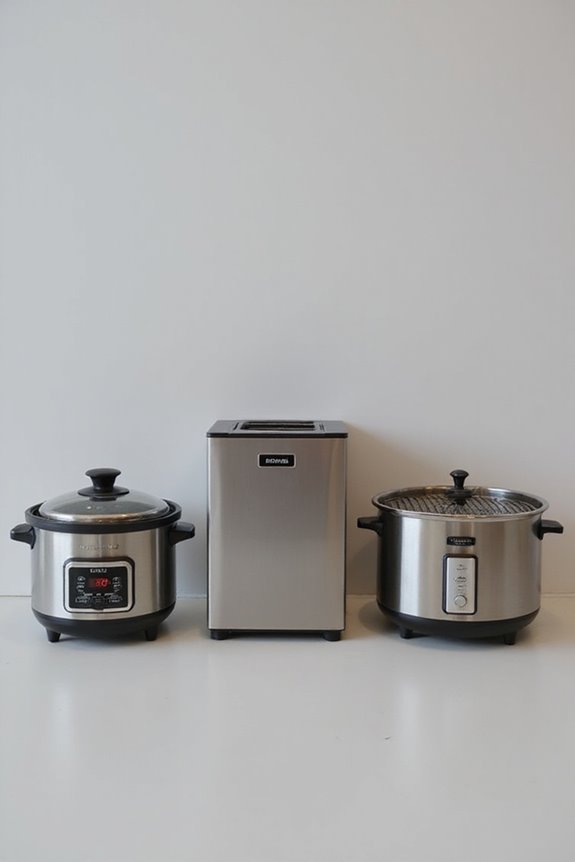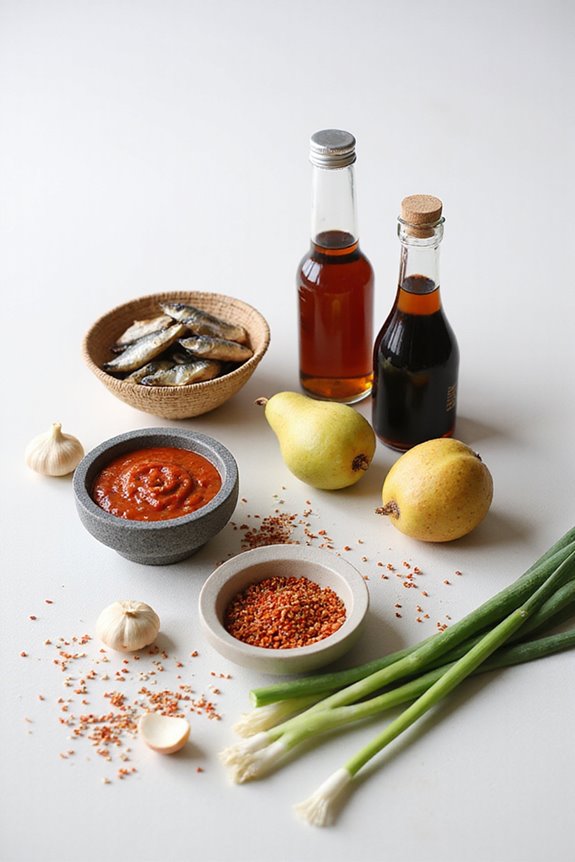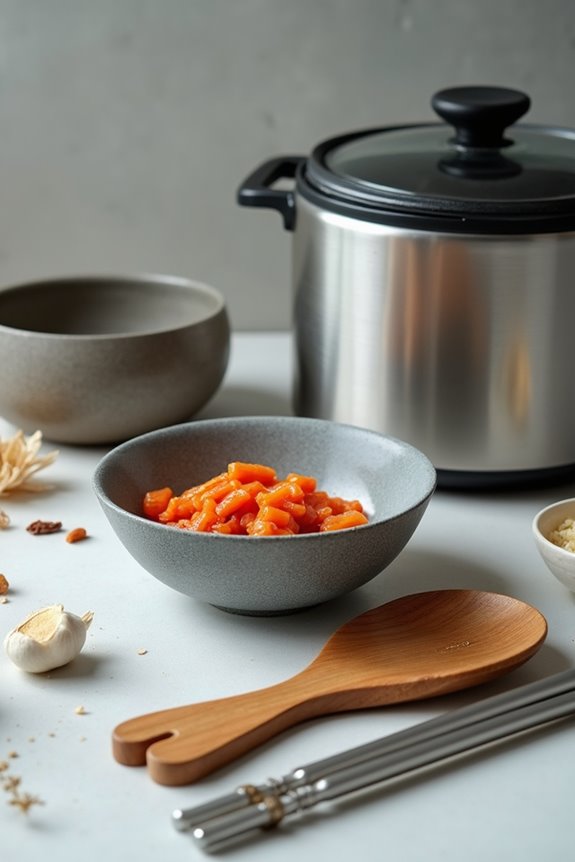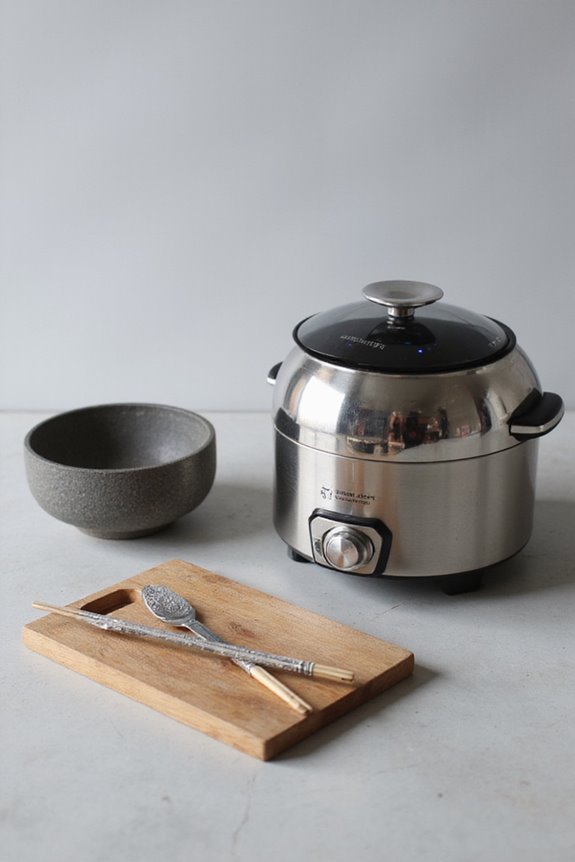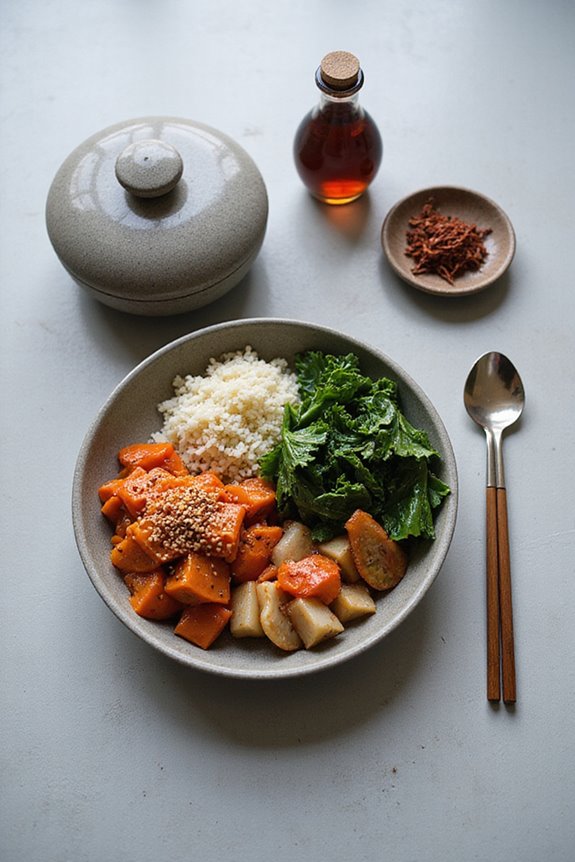Using Korean kitchen appliances is straightforward when we comprehend their functions. For rice cookers, we can select specific modes for different types of rice, ensuring best texture and flavor. Korean BBQ grills require us to choose appropriate fuel types, like gas or charcoal, and regular maintenance is necessary for performance. Specialty cookware like dolsots enhances traditional dishes, while efficient vegetable preparation techniques elevate presentation and taste. Additionally, kimchi refrigerators maintain ideal fermentation conditions. Exploring these tools can enhance our culinary skills.
Key Takeaways
- Familiarize yourself with your rice cooker’s various modes to cook different rice types perfectly, such as white, brown, and GABA.
- Select the appropriate Korean BBQ grill type based on your preference for flavor, convenience, and setup time.
- Utilize specialty cookware like dolsot for bibimbap to enhance texture and ensure traditional warmth in your dish.
- Employ proper vegetable preparation techniques, like strategic blanching and uniform slicing, to maximize quality and presentation in your meals.
- Use a kimchi refrigerator to maintain optimal fermentation conditions and develop the best flavors, adjusting temperature and humidity as needed.
Understanding Rice Cookers and Their Functions
Understanding rice cookers and their functions is essential for anyone looking to elevate their cooking experience. Modern rice cookers include various cooking modes tailored for different rice types, like white, brown, and GABA rice. Induction heating technology guarantees even cooking and fluffier rice by generating heat directly in the inner pot, while pressure cooking enhances texture by speeding up cooking and improving water absorption. Most models offer multiple preset programs to prepare not just rice, but also porridge, soups, and stews. The inclusion of smart technology adds convenience, allowing for remote control via mobile apps. By grasping these functionalities, we can maximize our rice cooker’s potential, cooking meals that cater to our dietary preferences and scheduling needs. Additionally, understanding cooking technology can help you choose the right rice cooker to achieve the best results for different rice types.
Getting Started With Korean BBQ Grills
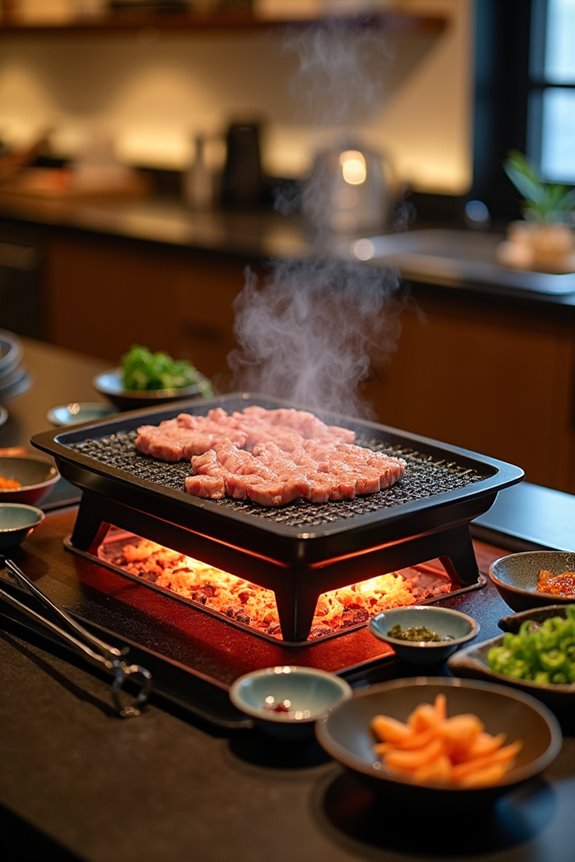
When it comes to enhancing our dining experiences, Korean BBQ grills present an exciting option for both novice and experienced cooks alike. We can choose from various grill types, such as portable gas grills, charcoal options, and smokeless electric models. Each type has unique fuel requirements that we should consider when choosing fuel types. Gas grills are quick to set up with compatible canisters, while charcoal grills require more preparation for flavor. It’s crucial to follow grill maintenance tips, such as regularly cleaning the grill plates and inspecting safety devices for wear. With the right care, we can guarantee our grills perform well, providing delicious meals while expanding our culinary repertoire beyond traditional cooking methods.
Utilizing Specialty Cookware for Traditional Dishes
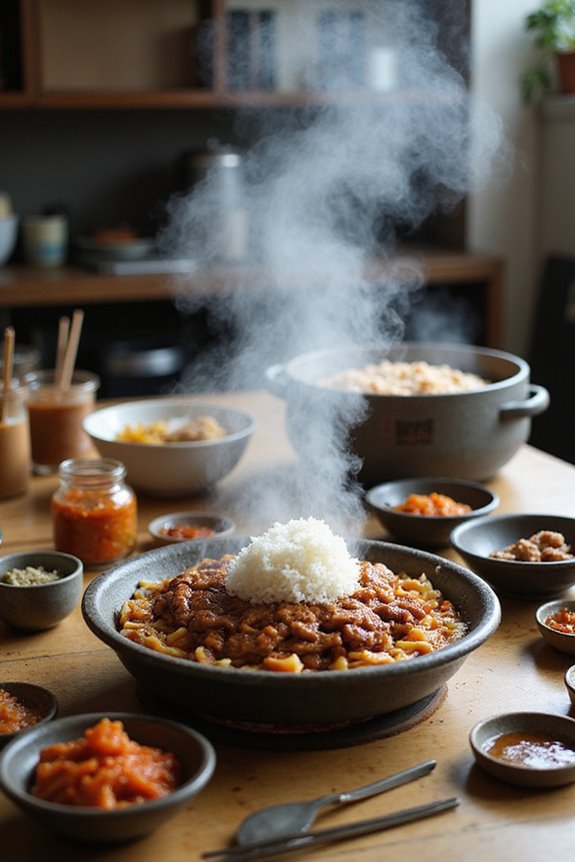
Utilizing specialty cookware in our kitchens can greatly enhance the preparation of traditional Korean dishes. For instance, we can create dolsot bibimbap by using a dolsot, a stone pot that retains heat and crisps rice when heated directly on the stove. This technique not only elevates the texture of the dish but also keeps it warm during serving. Likewise, onggi fermentation plays a significant role in developing authentic flavors for staple ingredients like kimchi and doenjang. The porous nature of onggi allows for proper airflow and humidity control, ideal for fermentation processes. By employing these specialized cooking tools, we can guarantee our dishes remain true to their roots while benefiting from the unique qualities that each piece of cookware provides. Additionally, using a Korean kimchi container can help maintain the freshness and flavor of your homemade kimchi during fermentation.
Efficient Vegetable Preparation Techniques
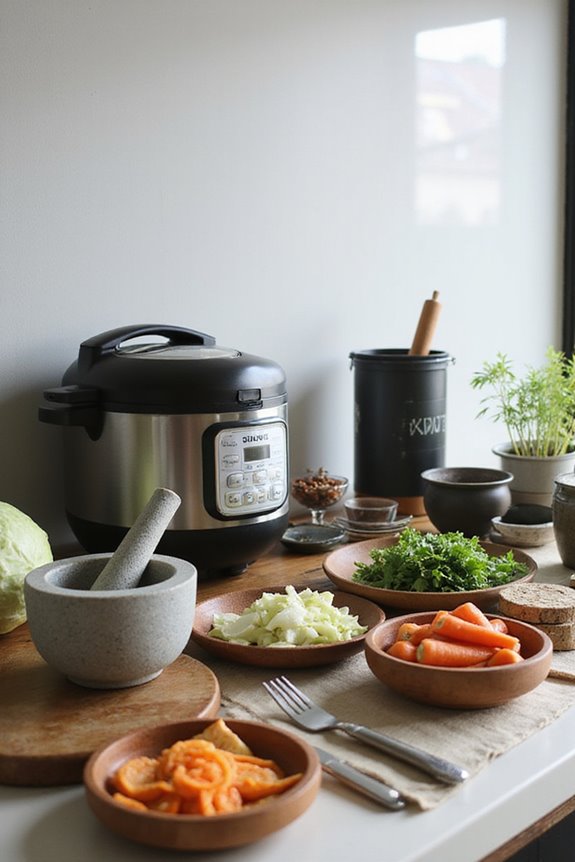
Incorporating specialty cookware is just the beginning of mastering traditional Korean cuisine; efficient vegetable preparation techniques also play a significant role in achieving authentic flavors and textures. First, we focus on vegetable slicing, where using sharp knives and kitchen mandolines guarantees uniform cuts. Consistent slicing not only enhances visual appeal but also assures even cooking. Next, we apply strategic blanching to vegetables like broccoli and green beans. Quick blanching in salted water retains color and crunch, enhancing flavors effectively. Monitoring the timing carefully prevents overcooking, allowing us to enjoy vegetables at their best. By mastering these techniques, we streamline our vegetable prep, paving the way for creating delicious and authentic Korean dishes that impress.
The Role of Kimchi Refrigerators in Fermentation
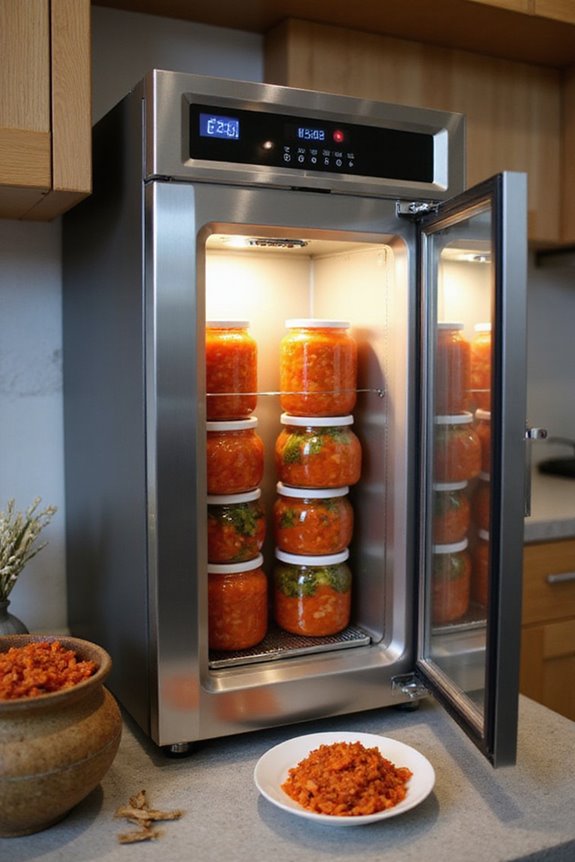
To achieve ideal fermentation of kimchi, it is essential to understand the pivotal role that specialized kimchi refrigerators play in this process. These appliances maintain ideal temperatures between 0°C to 5°C, which slow fermentation while preserving texture and flavor. For effective kimchi storage, tightly packing containers guarantees proper brine coverage and limits air exposure that could lead to spoilage. Additionally, adjustable temperature controls allow for slight increases that support the fermentation benefits associated with a controlled environment. By maintaining consistent humidity and preventing over-fermentation, we help develop more complex flavors and balanced acidity. Ultimately, the design and functionality of kimchi refrigerators facilitate the safe, effective, and flavorful fermentation process necessary for delicious kimchi.
Enhancing Air Quality With Kitchen Essentials
As we consider the role of specialized appliances in our kitchens, the enhancement of air quality emerges as a significant aspect of a functional cooking environment. Korean air purifiers contribute effectively to this need with advanced air purifier features designed for excellent performance. They utilize diesel particulate filter technology to capture odors, microdust, and other kitchen pollutants. This guarantees significant odor reduction during cooking by breaking down harmful particles. Additionally, the compact design and efficient coverage of models like Coway Airmega allow them to operate seamlessly in small spaces, quickly filtering large areas. These appliances also feature real-time air quality detection, guaranteeing ideal adjustment to fluctuating conditions and enhancing overall kitchen cleanliness for a healthier cooking experience.
Multi-Use Tools for Streamlined Korean Cooking
When preparing Korean dishes, the use of multi-use tools greatly enhances our kitchen efficiency and overall cooking experience. Appliances like rice cookers and food processors streamline meal prep efficiency, allowing us to create authentic flavors with ease. A rice cooker, particularly advanced models, can handle steaming and baking, reducing the number of appliances needed. The food processor excels in chopping and grating, cutting down on time spent on kimchi preparation. Additionally, tools like silicone spatulas and large colanders help maintain kitchen organization tips by neatly managing ingredients. Utilizing mandoline slicers guarantees uniform cuts for dishes such as bibimbap, enhancing presentation and cooking consistency. Overall, integrating these versatile tools into our cooking routine improves both efficiency and enjoyment in preparing Korean meals. Furthermore, using a Korean food mill can elevate your cooking by allowing for precise texture control in purees and sauces.
Frequently Asked Questions
How Do I Clean and Maintain a Rice Cooker?
For effective rice cooker maintenance, we should follow proper cleaning techniques, rinsing after use, scrubbing with a mild detergent, and ensuring it’s dry before storage. This keeps our appliance in great shape for delicious meals!
What Type of Charcoal Is Recommended for Korean BBQ Grills?
When it comes to Korean BBQ grills, we prefer lump charcoal for its high heat and clean burn. Compared to briquettes, it offers better flavor and easier refueling, making our grilling experience truly enjoyable.
Can I Use Dolsot Bowls in the Oven?
Absolutely, we can use dolsot bowls in the oven! Let’s remember oven safety tips and the bowl’s materials to prevent cracking. Preheat gradually and follow the guidelines for the best results in our cooking adventures!
How Do I Store Leftover Kimchi in a Refrigerator?
Think of our kimchi as treasure; to protect it, we’ve got to store it right! Let’s keep it submerged in brine, in airtight containers, and follow these refrigerator tips to preserve its vibrant flavor.
What Appliances Are Essential for Small Korean Kitchens?
In our small Korean kitchens, we prioritize kitchen organization with essential utensils like compact rice cookers, multi-purpose grills, and efficient food processors. These tools maximize space while enhancing our cooking experience and meal preparation.

